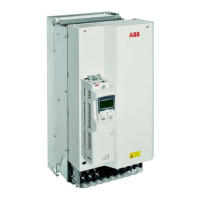Resistor braking
137
Resistor braking
What this chapter contains
This chapter describes how to select, protect and wire brake resistors.
Availability of brake choppers and resistors
Brake choppers are optionally available as built-in units, indicated in the type
description by +D150.
Resistors are available as add-on kits.
When is resistor braking needed
Typically, a drive system is equipped with brake choppers and resistors if:
• high capacity braking is needed and the drive cannot be equipped with a
regenerative supply unit
• a backup for the regenerative supply unit is needed.
Operation principle
The energy generated by the motor during a fast deceleration of the drive typically
causes the voltage to rise in the drive module intermediate DC circuit. The chopper
connects the brake resistor to the intermediate DC circuit whenever the voltage in
the circuit exceeds its maximum limit. Energy consumption by the resistor losses
lowers the voltage until the resistor can be disconnected.
Hardware description
The resistors available from ABB as add-on kits are built in an IP00 metal frame.
2×SAFUR and 4×SAFUR resistors are connected in parallel.
Planning the braking system
Selecting the brake circuit components
1. Calculate the maximum power (P
max
) generated by the motor during braking.

